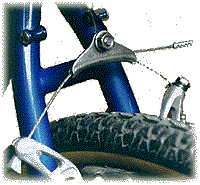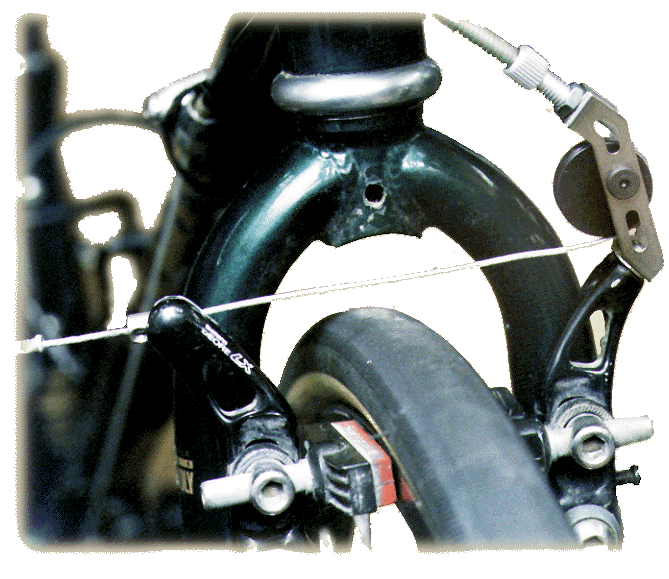|
Translation of this article:
German |

|

Traditional cantilever brakes are a type of rim brake. In connection with this article, please read the lead article about rim brakes. It covers, among other things,
Most brake problems result from excessive friction or poor installation of the cables, not poor setup, or poor quality brakes. Also see the article on cables for information on cable selection and adjustment of brake cables and brake levers.
![]()
![]()
I have another article on this site which deals with the theoretical aspects of traditional cantilever brakes, with a detailed explanation of their geometry and definitions of various terms. That article focuses on tuning the mechanical advantage of a traditional center-pull cantilever system.
This article has more of a focus on practical setup tips, though I have provided links to the theoretical aspects, for those who wish to understand the theory behind the practical advice.
Traditional cantilevers used two separate cables, a main cable running down from the control lever, and a "transverse" or "straddle" cable running between the two cantilevers. The main cable would be clamped to a triangular "yoke", a sort of hook that pulled up on the transverse cable.
These worked OK until mountain bikes came along, then there was a rash of bad crashes caused by failure of the main cable. The cable would part at the lever or where it passed over a pulley. When the main cable let go, the cantilevers would spring apart, and the transverse cable would catch on the knobs of the tire, causing sudden wheel lockup...ouch!
In response to this, Shimano developed the "link wire." The link wire replaces the yoke and half of the transverse cable. The main cable goes through the "button" that serves as the yoke, and extends down to one side of the cantilevers, supplying the other side of the "virtual" transverse cable.
Use a reflector bracket, fender or other device to prevent the transverse cable from catching on the tire. This may still be advisable with a link wire. Check for yourself whether it could contact the tire when the cable is disconnected from the lever.
The button has a line printed on it which is intended to align with the extended cable.
There was some initial resistance to this arrangement because it isn't quite as adjustable as a separate yoke (you can adjust it by choosing among different length link wires.) In fact, however, the link wire is generally a superior system. Unlike traditional transverse cables that curve over the yoke when the brake is not being applied, link wire systems keep all cable segments running straight. This reduces wasted motion, and allows a better brake adjustment.
Link wires are commonly available in five lengths:
| Code | Length | |
|---|---|---|
| S | 63 mm | |
| A | 73 mm | |
| B | 82 mm | |
| C | 106 mm | |
| D | 93 mm |
![]()
![]()
When the brake is released, the brake shoes retract away from the rim. Ideally, the shoes on both sides should back off by the same amount. If they don't, the brake is not properly centered. In extreme cases, one of the shoes may not retract, and may rub on the rim even when the brake is not being applied.
If a brake appears off-center, check first that the wheel is installed straight in the frame/fork. If the wheel is crooked, and you maladjust the brake to compensate, you are creating two problems where there was only one before.
If the brake is, in fact, off-center, it is often the result of too much friction on one of the cantilever bosses. Unhook the transverse cable, and try moving each cantilever individually by hand. They should move smoothly and freely, and always come to rest near the same position. If you suspect friction, unscrew the bolt that holds the cantilever to the boss, and remove the cantilever. The surface of the boss should be smooth, free from rust, and coated with grease. If it is rusty, that is usually a sign that the bicycle was sloppily assembled at the dealer who sold it. Use emery cloth or sandpaper to remove the rust, and wipe off the dust and sand. Coat the boss with grease, and re-install the cantilever.

Some Dia Compe style brakes have these adjustable spring blocks on both sides, others have one only on one side, with the other side using the normal spring holes in the boss.
![]()
![]()
A brake system with too little mechanical advantage will push the shoes against the rim quickly, but won't push them hard enough. The levers will feel firm because the shoes are not being pressed hard enough to cause them to flex.
If you have too little mechanical advantage, lowering the cable yoke so that the transverse cable is more nearly horizontal will help. If you have low-profile cantilevers, artificially "widening" the profile will also increase mechanical advantage: set the transverse cable wide enough that the shoes have to be exended inward on their bosses to reach the rim.
In some cases, what appears to be inadequate mechanical advantage turns out to be that the brake shoes are not "grippy" enough; they may be dirty, or dried out, or of low quality. Better-quality shoes can make a real difference. I particularly recommend Kool-Stop Salmon brake shoes, which have good grip and wear slowly.
| Excessive mechanical advantage can often be reduced by raising the cable yoke and lengthening the transverse cable, so that it makes a sharper angle around the yoke. Unfortunately, there isn't always room to raise the yoke far enough, especially in the rear of smaller frames.
A special wide yoke sometimes helps with this. It causes the transverse cable to run at a sharper angle than it would with a conventional yoke. |
 |
If you have too much mechanical advantage, as with a touring bike or tandem with drop-bar-type levers, you can, in some cases, use a pulley adaptor to convert your conventional cantilevers into direct-pull units. Note however that a pulley will result in fatigue failure of the cable sooner or later, so check it frequently.

![]()
![]()
Ideally, it should start out low, so that the brake shoes can be set for generous rim clearance. The low initial mechanical advantage will allow the shoes to move in toward the rim fast, in response to a small amount of hand-lever movement.
As the shoes get close to the rim, the mechanical advantage should increase, so that a small amount of hand force will result in a strong force pressing the shoes against the rim.
Some high-end brake levers, most notably the upper-end Shimano models with the "servo-wave" feature, are designed to do exactly this.
Unfortunately, conventional center-pull cantilevers prouduce exactly the opposite variation! As the lever is pulled, the yoke angle gets sharper and sharper, while, in the case of a low-profile model, the pivot-cable distance decreases. Both of these conditions reduce the mechanical advantage as the brake is applied.
Since the travel increases as the brake shoes wear down, braking performance degrades as the shoes wear, not because the shoes have any less grip, but because the mechanical advantage has decreased.
![]()
Last Updated: by Harriet Fell